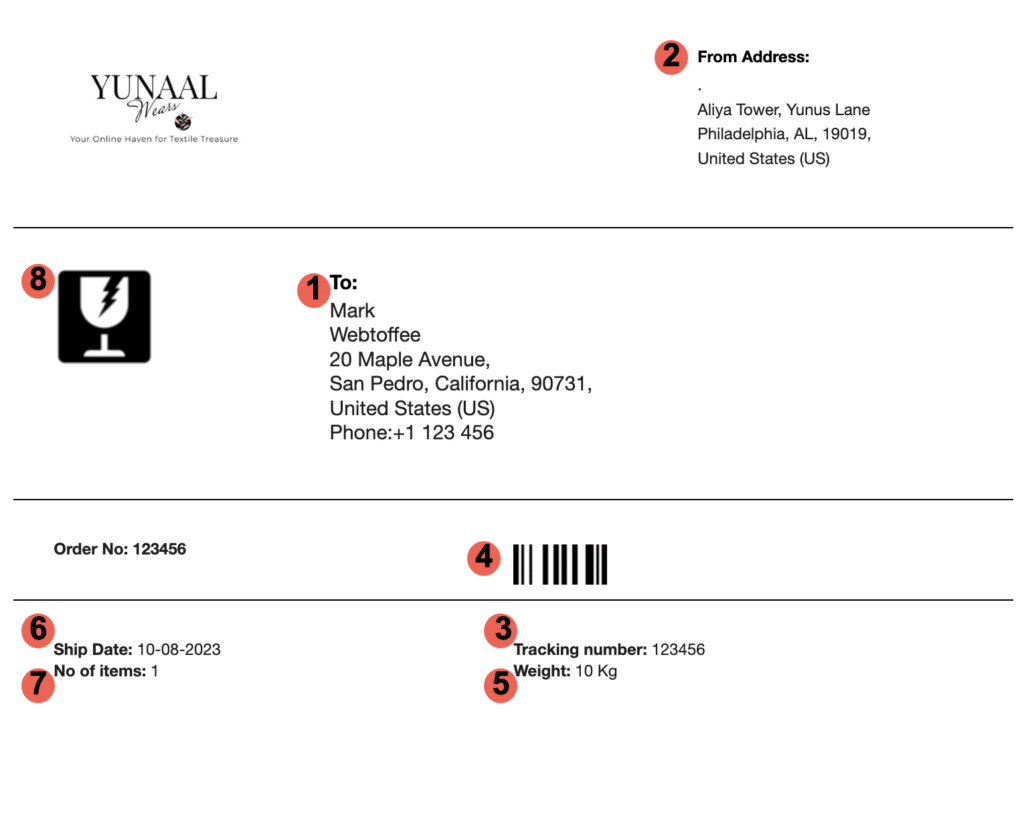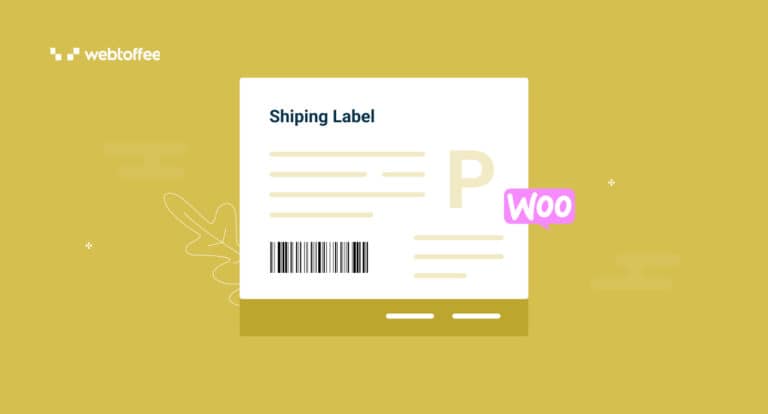In the world of eCommerce, where packages journey across the globe, there exists a seemingly small yet incredibly significant element: the shipping label. Despite its unassuming size, a shipping label plays an important role in ensuring the smooth flow of goods, both into and out of the marketplace.
Far beyond its basic function, this simple label holds the key to your online store’s triumph and the satisfaction of your valued customers. This blog will explain everything you need to know about shipping labels. So, let’s dive in and get familiarized with the term shipping label, its importance, how it works, and how they stand as the unsung heroes of modern logistics.
A shipping label is an information attached to a package or parcel being shipped that helps the carrier transport the parcel from the origin to the destination. It has important details that help the courier company know where the package should go. These labels are really important for online shopping deliveries since they help carriers route and deliver packages to their intended recipients accurately.
It contains essential information about the package, such as the destination address, sender’s address, tracking number, shipping method, and other relevant details. These details should be entered correctly to ensure efficient and reliable transportation during the shipping process. A small mistake in the package might delay it from getting to the right place or on time.

At a glance, a shipping label may seem complicated to understand. Let’s have a look at each of the details on a shipping label:
- Recipient’s Address: The destination address where the package should be delivered. This ensures accurate delivery to the intended recipient.
- Return Address: The sender’s address that allows the package to be returned if there are delivery issues or if the recipient isn’t available.
- Tracking Number: A unique code that allows both the sender and recipient to track the package’s journey and monitor its delivery status.
- Barcode and QR Code: These codes provide a scannable link to the package’s information, making it easy for carriers to handle and track shipments efficiently.
- Weight and Dimensions: The weight and size of the package are included to help calculate shipping costs and ensure proper handling.
- Shipping Date: The date when the package was shipped, aiding in estimating delivery times and ensuring timely handling.
- Number of Items: Including the item count helps in verifying that the correct number of items have been packed and shipped.
- Handle with Care Labels: Indications to handle the package carefully if it contains hazardous, delicate, or fragile items.
Each of these elements contributes to a successful and smooth shipping process, ensuring packages reach their intended destinations accurately and efficiently.
Shipping labels are important for several reasons:
Accurate Delivery: Shipping labels provide the necessary information for carriers to accurately route and deliver packages to the correct destinations, ensuring that customers receive their orders on time.
Efficient Handling: The information on shipping labels, including barcodes and QR codes, allows automated systems and workers to quickly sort, process quickly, and track packages throughout the shipping journey.
Tracking and Visibility: Shipping labels with tracking numbers enable both senders and recipients to monitor the package’s progress in real-time, providing transparency about its status.
Customer Communication: Shipping labels may include special instructions or delivery preferences, facilitating smoother communication between customers and carriers.
Returns and Issue Resolution: In cases of delivery problems or returns, shipping labels play an important role by providing return addresses and tracking information, making it easier to resolve issues.
Brand Image: Well-designed and accurate shipping labels contribute to a professional brand image, indicating reliability and attention to detail.
Customer Satisfaction: Accurate and informative shipping labels contribute to a positive customer experience by minimizing delivery errors, delays, and miscommunication.
In essence, shipping labels serve as a critical link between sellers, carriers, and customers, ensuring that packages are handled, transported, and delivered effectively and efficiently.
Using Online Shipping Platforms: You can utilize online shipping platforms provided by carriers like USPS, FedEx, UPS, or DHL. You will have to sign in, enter shipment details, select a template, and generate/print the label.
Using eCommerce Platforms: If you’re selling products online, many e-commerce platforms (like Shopify, WooCommerce) offer integrated shipping label creation. You can generate labels directly from your order management system.
Using software and tools: You can also design and create labels using word processing software or specialized shipping label software. You will have to input recipient and sender details, package information, and carrier specifications, and then print the label. Additionally, various eCommerce platforms offer a range of add-ons for creating shipping labels.
Each method has its advantages and may vary based on your needs, the volume of shipments, and the level of integration you require.
Two main types of printers commonly used for printing shipping labels are thermal printers and laser printers.
Thermal printers: These printers are popular for shipping labels due to their simplicity and efficiency. They use heat to create an image on special thermal paper, eliminating the need for ink or toner. This makes them cost-effective and low-maintenance, with no smudging or fading over time. They are well-suited for high-volume label printing and are known for their fast printing speeds, making them ideal for busy shipping environments.
Laser printers: These printers provide a versatile option for printing shipping labels. They produce high-quality, precise prints using toner on regular paper or label sheets. Laser printers are capable of handling a variety of label sizes and designs, offering flexibility to customize labels as needed.
When choosing between these two printers, consider the volume of labels you need to print, your budget, and the level of customization required. Thermal printers excel in high-speed, high-volume scenarios, while laser printers offer flexibility and quality for businesses with diverse printing needs.
When placing a shipping label on a box, it is essential to put it on the largest flat surface available, ideally on the top. Always choose a side of the box that is clean, smooth, and unobstructed by seams, folds, or any other irregularities.
Make sure the label is securely attached, ensuring that all edges are firmly adhered to prevent any peeling or damage during transit. Placing the shipping label in a prominent and easily visible location helps ensure accurate scanning and efficient handling throughout the shipping process.
Best practices for shipping labels are important to ensure the smooth and accurate transit of packages. Here are some key guidelines to follow:
Clear and Legible Information: Make sure all information on the label is clear, legible, and accurate. This includes the recipient’s name, address, contact number, and any special instructions.
Standardized Address Format: Use a standardized address format with accurate abbreviations, spacing, and punctuation to avoid confusion and delays.
Barcode Quality: If using a barcode, ensure it is of high quality and properly printed to ensure accurate scanning and tracking.
Orientation: Ensure the label is right-side up and easy to read, minimizing the chances of mishandling due to label orientation.
Protection from Elements: Use a transparent adhesive pouch or clear packing tape to protect the label from moisture, smudging, and wear.
Consistency with Packaging: Ensure that the label matches the information on the packaging manifest, packing slip, and any other accompanying documents.
Tracking and Confirmation: Utilize tracking numbers and shipping confirmation to monitor the progress of your package and address any potential delays promptly.
By following these shipping label best practices, you can enhance the efficiency and reliability of your shipping process, reduce errors, and provide a better experience for both senders and recipients.
Conclusion
Shipping labels play an important role in the world of logistics, ensuring that packages reach their intended destinations swiftly and accurately. By adhering to best practices such as clear and legible information, proper label placement, and barcode quality, businesses can streamline their shipping processes and minimize the risk of errors or delays.
As a crucial bridge between senders and recipients, shipping labels not only facilitate the physical journey of a package but also represent a commitment to professionalism and customer satisfaction. Embracing these practices empowers businesses and can make a remarkable difference in efficiency at every step of the way.



